Once you've inserted a coin into the cabinet of Namco's Japan-only 1993 baseball arcade game Great Sluggers, the text "PUSH 1P OR 2P" will appear upon the screen (as with all seven World Stadium games, it allowed two players to play on one credit); if you press that 1 Player Start Button, the game will proceed to a menu from which you will have to pick one of three Kanji/Katakana texts: nōmaru gēmu (ノーマルゲーム), which means "normal game", puro yakyū kōshiki-sen (プロ野球公式戦), which means "pro baseball official game", and puro yakyū tōnamento (プロ野球トーナメント), which means "pro baseball tournament", before proceeding to the team selection screen, but if you pressed the 2 Player Start Button, the game will proceed directly to the team selection screen. You will then be given forty-four seconds to select one of those twelve returning teams by pushing the joystick up, down, left and right, before pressing the first button to confirm your choice - and as in all seven World Stadium titles, if you had only pressed that 1 Player Start Button, you'll now have to select a second team for the CPU to predetermine the behaviour of, but if you'd pressed the 2 Player Start Button, that second player will now have to pick a second team to take control of (which, as in all seven World Stadium titles, is too bad if that first player happened to have chosen that team he wanted to take control of). All twelve teams are also real, and their namings (much like Super World Stadium '93) reflect their 1992 lineups.
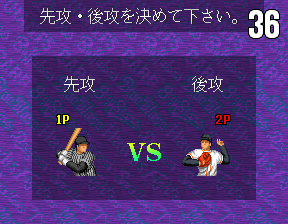
The game will then proceed to the new position selection screen, as the timer in the top-right corner of the screen continues counting down; it displays the Kanji texts senkō (先攻), which means batting first (1P), and kōkō (後攻), which means after the attack (2P) with one player from the first player's chosen team in his home outfit (holding his bat), and another one from the second player's chosen team in his away outfit (wearing his mitt) beneath them. Either player can push their joystick to the right to change the player from the first player's team into his away outfit (swapping his bat for a catching mitt) and the other one from the second player's team into his home outfit (swapping his catching mitt for a bat, and both Kanji texts' positions will also be swapped) then push it back to the left after doing that to change them back to how they had been before, before pressing the first button to confirm their choices - and the game shall now proceed to its new defensive-half selection screen, which displays the flags of the Central and Pacific Leagues with the Kanji texts DH-sei mu (DH制無) which means no defensive-half system (Central League flag) and DH-sei yū (DH制有) which means defensive-half system (Pacific League flag) above them, so once you have pushed the first button to confirm your choice (after either player pushes their joystick to the right to select the latter option if they wish), you shall have to select one of three Katakana (and Kanji) texts determining the mode of play: Manyuaru (マニュアル), Gaiya jidō (外野自動) or Uchi gaiya jidō (内外野自動) by pushing your joystick up and down, then pressing that first button to confirm your choice. The game will then proceed onto its new team lineups screen; all 96 of the players' names also have their abbreviated positions next to them, but the name next to the number 9 will, much like in the last three World Stadium titles, always be tōshu (投手), which means pitcher, with a "P" next to it as the game has not proceeded to its new pitcher selection screen yet. However, once it does, the timer will still continue counting down, and you will now have to select one of your chosen team's six pitchers by pushing the joystick up and down, then pressing the first button to confirm your choice - but if you only pressed the 1 Player Start Button, the CPU will automatically select the first of its team's six pitchers to predetermine the behaviour of. All 72 pitchers' names also have either the Kanji characters hidari (左) or migi (右) next to them which indicates whether they will pitch while facing to the left or the right; you will then have to select one of two more Kanji/Katakana texts determining the audio: Nessen mōdo (熱戦モード) or BGM mōdo (BGMモード) by pushing the joystick up and down and pressing the first button to confirm your choice. The game shall then proceed onto the new stadium selection screen - and you shall now have to select one of this game's four new stadiums for the match to take place in (the second of them was initially known as "Kōshien" for the World Stadium titles), which all have different "centre" and "both wings" measurements, given in metres for all four (the Urban Stadium is also based on the Kōrakuen from the first three WS titles):
| Stadium | Name | Chūken (中堅) | Ryōyoku (両翼) |
|---|---|---|---|
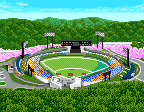
|
Hillside (ヒルサイド) | 120.0m | 95.0m |
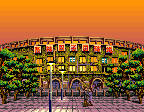
|
Trad (トラッド) | 118.1m | 96.0m |
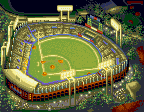
|
Urban (アーバン) | 120.0m | 90.9m |

|
Kaihei Dome (開閉ドーム) | 122.0m | 100.0m |
...and after you have pressed the first button to confirm your choice, the screen will fade out before fading back into a shot of the sky above your chosen stadium. The camera will then pan down to the field of the stadium as all eighteen players (and all six umpires) run out and take their positions on it, and both of your chosen teams' logos will then fly into view from the left and right sides of the screen, as a "VS" appears between them; the Hillside Stadium features an advertisement for Starblade, the Trad (Kōshien for WS players) Stadium features an advertisement for Depāto (デパート) with Pac-Man and another for Namco's then-existent "Wonder Eggs" theme park, the Urban Stadium has three advertisements for Mappy and Pac-Land and two murals of a Pooka and a Fygar from Dig Dug, and the Kaihei Dome Stadium features advertisements for Dig Dug, Net-tō! Geki-tō! Quiz-tō!!, Final Lap, Emeraldia, Pac-Man, World Stadium, Numan Athletics, and the then-existent "Wonder Eggs" theme park which closed at the end of 2000. The match will then start.
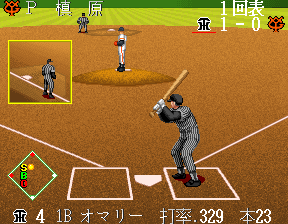
The view will now change to a shot of the centre of the stadium's field, as the Katakana text purei bōru (プレイボール), which means "play ball", flies into view from the right side of the screen and disappears off the left one; the score will now be displayed up in the top-right corner of the screen (with the batting team's initial underlined in red) under the number of 1 and the two Kanji characters of kai omote (回表), which means "front time". The statistics of the No. 1 from that first player's team will again be displayed in that bottom-left corner of the screen below that team's initial - and the statistics of the chosen pitcher from that second player's team will also be displayed in the bottom-right corner of the screen below the team's initial. The first player must use his joystick to position his batter inside that batting box, and the second player must push his joystick to the left or right to position his pitcher upon the pitcher's mound, then press his first button to throw the ball; he must now push the joystick to the left if he wants the ball to curve horizontally, down-left if he wants it to curve vertically, right to shoot horizontally, down-right to shoot vertically, down to fork and up to be a speed ball. If the other player's team's current batter failed to hit it, the Katakana text of sutoraiku (ストライク), which means "strike", will appear upon the screen, with the speed at which that ball travelled in kilometres above it, as a yellow circle appears next to the letter "S" on the left side of the screen - and you both then have to repeat the pitching process, but if the other player's team's current batter fails to strike the ball again, the Katakana text sutoraiku (ストライク) will again appear on the screen, with the speed at which the ball travelled in kilometres above it, as a second yellow circle appears. You will both then have to repeat that pitching process again, but if the other player's team's current batter fails to hit that ball once again, the Katakana text battā auto (バッターアウト) which means "batter out", will appear upon the screen (with the speed at which the ball had travelled in kilometres above it), as both yellow circles next to the letter "S" disappear and an orange circle appears next to the letter "O" below it and the other player's team's next batter is brought in; he will have different statistics. Those text boxes that were introduced in Super World Stadium '93 will also reappear on the left side of the screen: Heisatsu-da (併殺打), which means: "hitting double play", Hitto (ヒット), which means "hit", Niruida (二塁打), which means: "two-based hit", Sanruida (三塁打), which means "three-based hit", Honruida (本塁打), which means "home run", Gifurai (犠フライ), which means "sacrifice fly", Gibanto (犠バント), which means: "sacrifice bunt", Shikyū (死球/四球), which means "dead ball" or "walk", Uchifurai (内フライ), which means "fly in", Uchigoro (内ゴロ), which means "grounder in", Sotofurai (外フライ), which means "fly out", Sotogoro (外ゴロ), which means "grounder out", Funige (振逃げ), which means: "shake relief", Shissaku (失策, which means "mistake", and Yasen (野選), which for a second time only means what it is read as.

The first player must press the first button to make his batter swing and the second button to make him bunt; once he has struck the ball, the view will change to a shot of your stadium's field as it flies up into the air. If the ball does not land within the white lines, the umpires (of which there are six) will hold their arms up and the Katakana text fauru (ファウル), which means "foul", will appear upon the screen and it will be counted as a strike - this will also be signified by a yellow circle appearing next to that letter "S", once the view returns to the image you see above. Also, if the current batter hits the ball so hard that it flies out of the stadium, the Katakana text hōmu ran (ホームラン), which means "home run", will appear upon the screen with the distance that the ball travelled in metres next to the Kanji text hikyori (飛距離), which means "flying distance", and the Katakana (or Kanji) text for where the ball landed (レフトスタンド: "left stand", バックスクリーン: "back screen", ライトスタンド: "right stand", ラッキーゾーン: "lucky zones" for the Trad Stadium, and 場外: "curb", for all of the stadiums except for the Kaihei Dome Stadium), below it; the current score will then be displayed upon the screen (the teams are still represented by their logos), as a window rotates into view at the bottom of the screen showing your chosen team's players running around the bases as their mascot(s) cheer them on (and if you'd chosen to take control of either the Yomiuri Giants or Hanshin Tigers, you will have the chance to see their secondary mascots, "Sister Giabbit" and "To Lucky"). If the ball landed within the white lines after your chosen team's current batter hit it and one of the other players on your chosen team caught it as it fell back down to the ground, you will have to press the first button to make him throw it to one of the other players while pushing the joystick up and down to indicate which player you want him to throw it to; once you have done so, all the umpires will either hold their arms out, and the Katakana text of sēfu (セーフ), which means "safe", will appear on the screen if the player was safe, or they'll hold their right arms up, and the different Katakana text of auto (アウト), which means "out", will appear on the screen if he was out (yet again, this will also be counted as an out, and it will be reflected by one orange circle appearing next to the letter "O" once the view has returned to that screenshot you see above). The radar of the field which now appears down in the bottom-left corner of the screen shows the positions of that other team's players (indicated by the moving hats, which still match the colours of their own) - and when your team is batting and the other player's team is pitching, push your joystick up and press the first button to tag out a runner on the other player's team who is attempting to steal a base (they can still be seen in the windows, on the left and right sides of the screen). Once you have done so, the runner will run out of sight from the left side of the screen, as the other player's team's chosen pitcher throws the ball; once your team's current batter has struck on the ball, the view will again change to a shot of the field as it flies up into the air, but the other player's team's chosen pitcher will then run off the pitcher's mound, and onto the catcher's plate. You will now have to push your joystick to the left and press your first button to make your chosen team's runner start running, then push your joystick up, and press your second button to make him run back again - and once three outs have occurred, the view will cut to an overhead shot of your chosen stadium (in all except that of the Hillside Stadium, there will also be crowds cheering) with a scoreboard at the top of the screen and a list of the next three batters on the right side of the screen (or the left side of the screen, if it is the first player's turn to bat again). The match will then continue.
-
The Yomiuri Giants' secondary mascot, "Sister Giabbit".
-
The Hanshin Tigers' secondary mascot, "To Lucky".
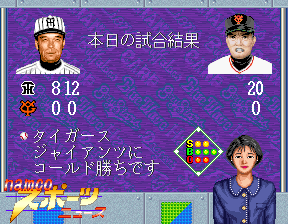
It will now be the first player's turn to pitch and the second player's (or the CPU's) turn to bat; the score display will also have the initial of the second player's team underlined in red as a result of this, and the text above will now read as the Kanji/Katakana of kai ura (回ウラ), which means "back time". The game continues until preset number of innings (depending on what that arcade owner has set "CONTINUE1" and "CONTINUE2" settings in the game's options menu to), have been played (you then have to insert another coin, and press either Start Button within 15 seconds, to continue your game each time). Once nine full innings have been played, or the losing team are down by ten runs in the bottom of any inning (however, if both of your teams have the same amount of runs after nine full innings have been played, your game will continue for up to three extra ones - and if either of the two teams scores thirty runs, the game will automatically be called) the Katakana text gēmu setto (ゲームセット) which means "gameset" will appear upon the screen, before it fades to black. The screen will then fade back into a shot of your chosen stadium's exterior, with the Pacific League's six mascots running past at the top of the screen and the Central League's ones running past at the bottom; the Katakana text of supōtsu (スポーツ), which means "sports", will then fade into view in the centre of the screen, while the additional Katakana text of Namuko (ナムコ) which means "Namco", and nyūzu (ニューズ) which means "news", zoom into view above and below it. Both of the teams' logos will now fly into view from the left and right sides of the screen as the number of runs that they scored appear below them - and the screen will now fade out to a shot of a female reporter in a studio. The amounts of runs that both teams scored during the top and bottom of each inning shall be displayed at the top of the screen, along with two rotating trading cards in the top-left and top-right corners of the screen, that display the teams' logos on their fronts and their managers on their backs (the one for the winning team will be smiling, and the one for the losing team will be frowning), as the following three-script texts appear on the left side of the screen; they change each time the two trading cards rotate, and the fourth one is different for all four stadiums:
The screen will then fade out to a shot of the mascot of the winning team walking into view from the right side of the screen and falling over; the mascots of the other eleven teams (primary ones in the case of the Yomiuri Giants and Hanshin Tigers) will then run into view from the left side of the screen and chase him back off the right side of the screen, only to be chased back off the left side of the screen even faster by a group of 144 identical clones of the aforementioned mascot of the winning team. Eight baseballs will then fly towards the centre of the screen, transforming into the letters that spell out that familiar text of "GAME OVER" as they hit it - and the game will then go back into attract mode, before displaying its current team positions and statistics. However, if both teams have scored the same amount of runs after up to three extra innings have been played, the reporter will speak the following text:
The screen will then fade out to a shot of the mascot of the first player's team (even if they didn't win), walking into view from the right side of the screen, and falling over as usual; the mascots of the other eleven teams (again, primary ones in the case of the Yomiuri Giants and Hanshin Tigers) will now run into view from the left side of the screen to chase him back off the right side of the screen as usual, only to be chased back off the left side of the screen even faster by a group of 144 identical clones of the aforementioned mascot of the first player's team as usual - and eight baseballs will then fly towards the centre of the screen, transforming into the letters that spell out "GAME OVER" as they hit it. The game shall then go back into attract mode as usual.

